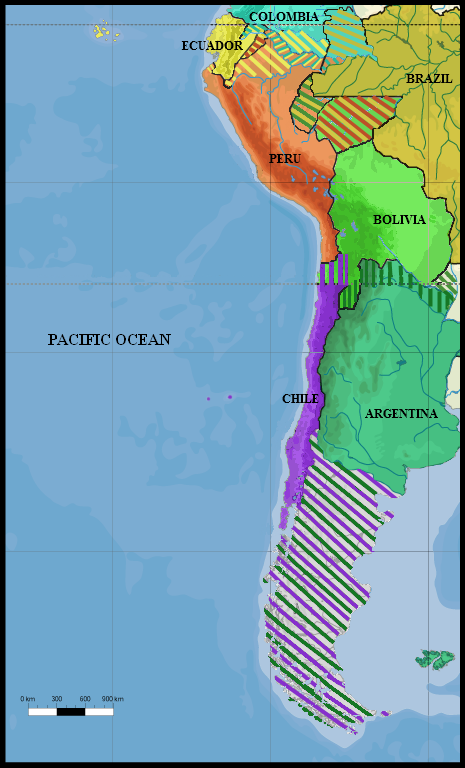|
Andrés Avelino Cáceres
Andrés Avelino Cáceres Dorregaray (10 November 1836 – 10 October 1923) was a Peruvian politician and general who served as the President of Peru, from 1886 to 1890 as the 27th president, and again from 1894 to 1895 as the 30th. He is considered a Peruvian national hero for leading the resistance against the Chilean occupation during the War of the Pacific (1879–1883), in which he fought as a general in the Peruvian Army. Early years Andrés Avelino Cáceres was born on 10 November 1833, in the city of Ayacucho. His father, Don Domingo Cáceres y Ore, was a landowner and his mother, Justa Dorregaray Cueva, daughter of the Spanish colonel Demetrio Dorregaray. He was ''mestizo''; one of his maternal ancestors was Catalina Huanca, an Inka-Wanka princess. He studied at the ''Colegio San Ramón'' () in his hometown. Military career In 1854, Cáceres abandoned his studies and joined the ''Ayacucho'' Battalion as a cadet. As part of this unit, he participated in the rebelli ... [...More Info...] [...Related Items...] OR: [Wikipedia] [Google] [Baidu] |
President Of Peru
The president of Peru (), officially the constitutional president of the Republic of Peru (), is the head of state and head of government of Peru. The president is the head of the executive branch and is the supreme head of the Peruvian Armed Forces, Armed Forces and National Police of Peru. The office of president corresponds to the highest magistracy in the country, making the president the highest-ranking public official in Peru. Due to broadly interpreted impeachment wording in the Constitution of Peru, 1993 Constitution of Peru, the Congress of Peru can impeach the president without cause, effectively making the executive branch subject to the legislature. The president is elected to direct the general policy of the government, work with the Congress of the Republic and the Council of Ministers (Peru), Council of Ministers to enact reform, and be an administrator of the state, enforcing the constitution, which establishes the presidential requirements, rights, and obliga ... [...More Info...] [...Related Items...] OR: [Wikipedia] [Google] [Baidu] |
Aurelio Denegri
Marco Aurelio Denegri Valega (1840–1909) was a Prime Minister of Peru under Andrés Avelino Cáceres in 1881. He was the mayor of Lima 1874–1875. He was Minister of Finance A ministry of finance is a ministry or other government agency in charge of government finance, fiscal policy, and financial regulation. It is headed by a finance minister, an executive or cabinet position . A ministry of finance's portfolio ... in 1879 and from 1881 to 1883. He served as the second vice president from 1886 to 1890. References ' 19th-century mayors of places in Peru Mayors of Lima Vice presidents of Peru Prime ministers of Peru Ministers of economy and finance of Peru 1840 births 1909 deaths {{Peru-politician-stub ... [...More Info...] [...Related Items...] OR: [Wikipedia] [Google] [Baidu] |
General
A general officer is an Officer (armed forces), officer of high rank in the army, armies, and in some nations' air force, air and space forces, marines or naval infantry. In some usages, the term "general officer" refers to a rank above colonel."general, adj. and n.". OED Online. March 2021. Oxford University Press. https://www.oed.com/view/Entry/77489?rskey=dCKrg4&result=1 (accessed May 11, 2021) The adjective ''general'' had been affixed to officer designations since the late medieval period to indicate relative superiority or an extended jurisdiction. French Revolutionary system Arab system Other variations Other nomenclatures for general officers include the titles and ranks: * Adjutant general * Commandant-General, Commandant-general * Inspector general * General-in-chief * General of the Air Force (USAF only) * General of the Armies, General of the Armies of the United States (of America), a title created for General John J. Pershing, and subsequently grante ... [...More Info...] [...Related Items...] OR: [Wikipedia] [Google] [Baidu] |
Chile
Chile, officially the Republic of Chile, is a country in western South America. It is the southernmost country in the world and the closest to Antarctica, stretching along a narrow strip of land between the Andes, Andes Mountains and the Pacific Ocean. Chile had a population of 17.5 million as of the latest census in 2017 and has a territorial area of , sharing borders with Peru to the north, Bolivia to the northeast, Argentina to the east, and the Drake Passage to the south. The country also controls several Pacific islands, including Juan Fernández Islands, Juan Fernández, Isla Salas y Gómez, Desventuradas Islands, Desventuradas, and Easter Island, and claims about of Antarctica as the Chilean Antarctic Territory. The capital and largest city of Chile is Santiago, and the national language is Spanish language, Spanish. Conquest of Chile, Spain conquered and colonized the region in the mid-16th century, replacing Incas in Central Chile, Inca rule; however, they Arauco War ... [...More Info...] [...Related Items...] OR: [Wikipedia] [Google] [Baidu] |
Peruvian Civil War Of 1884-1885
Peruvians (''/peruanas'') are the citizens of Peru. What is now Peru has been inhabited for several millennia by cultures such as the Caral before the Spanish conquest in the 16th century. Peruvian population decreased from an estimated 5–9 million in the 1520s to around 600,000 in 1620 mainly because of infectious diseases carried by the Spanish. Spaniards and Africans arrived in large numbers in 1532 under colonial rule, mixing widely with each other and with Native Peruvians. During the Republic, there has been a gradual immigration of European people (especially from Spain and Italy, and to a lesser extent from Germany, France, Croatia, and the British Isles). Chinese and Japanese arrived in large numbers at the end of the 19th century. With 31.2 million inhabitants according to the 2017 Census. Peru is the fourth most populous country in South America. Its demographic growth rate declined from 2.6% to 1.6% between 1950 and 2000, and its population is expected to reach a ... [...More Info...] [...Related Items...] OR: [Wikipedia] [Google] [Baidu] |
War Of The Pacific
The War of the Pacific (), also known by War of the Pacific#Etymology, multiple other names, was a war between Chile and a Treaty of Defensive Alliance (Bolivia–Peru), Bolivian–Peruvian alliance from 1879 to 1884. Fought over Atacama Desert border dispute, Chilean claims on Litoral Department, coastal Bolivian territory in the Atacama Desert, the war ended with victory for Chile, which gained a significant amount of resource-rich territory from Peru and Bolivia. The direct cause of the war was a nitrate taxation dispute between Bolivia and Chile, with Peru being drawn in due to its secret alliance with Bolivia. Some historians have pointed to deeper origins of the war, such as the interest of Chile and Peru in the nitrate business, a long-standing rivalry between Chile and Peru for regional hegemony, as well as the political and economical disparities between the stability of Chile and the volatility of Peru and Bolivia. In February 1878, Bolivia increased taxes on the Chile ... [...More Info...] [...Related Items...] OR: [Wikipedia] [Google] [Baidu] |
Peruvian Civil War Of 1894-1895
Peruvians (''/peruanas'') are the citizens of Peru. What is now Peru has been inhabited for several millennia by cultures such as the Caral before the Spanish conquest in the 16th century. Peruvian population decreased from an estimated 5–9 million in the 1520s to around 600,000 in 1620 mainly because of infectious diseases carried by the Spanish. Spaniards and Africans arrived in large numbers in 1532 under colonial rule, mixing widely with each other and with Native Peruvians. During the Republic, there has been a gradual immigration of European people (especially from Spain and Italy, and to a lesser extent from Germany, France, Croatia, and the British Isles). Chinese and Japanese arrived in large numbers at the end of the 19th century. With 31.2 million inhabitants according to the 2017 Census. Peru is the fourth most populous country in South America. Its demographic growth rate declined from 2.6% to 1.6% between 1950 and 2000, and its population is expected to reach a ... [...More Info...] [...Related Items...] OR: [Wikipedia] [Google] [Baidu] |
Marshal
Marshal is a term used in several official titles in various branches of society. As marshals became trusted members of the courts of Middle Ages, Medieval Europe, the title grew in reputation. During the last few centuries, it has been used for elevated offices, such as in military rank and civilian law enforcement. In most countries, the rank of Field marshal, Marshal is the highest Army rank (equivalent to a five-star General of the Army (United States), General of the Army in the United States). Etymology ''Marshal'' is an ancient loanword from Old French ''mareschal'' (cf. Modern French ''maréchal''), which in turn is borrowed from Old Frankish *' "stable boy, keeper, servant", attested by Medieval Latin ''mariscalcus'' from a Proto-Germanic ''*maraχskalkaz'' (cf. Old High German ''marahschalh'')p. 93b-283a, T. F. Hoad, ''The Concise Oxford Dictionary of English Etymology'' (Oxford University Press, 1993) being still evident in Middle Dutch ''maerscalc'', ''marscal'', ... [...More Info...] [...Related Items...] OR: [Wikipedia] [Google] [Baidu] |
Constitutional Party (Peru)
The Constitutional Party () was a political party in Peru. The party was founded in 1886 by Andrés Avelino Cáceres, a national hero from the War of the Pacific. The party was an expression of the nationalist and military oligarchy, in addition to the biggest landowners and the Catholic Church. The Constitutional Party formed an agreement with the Civilista Party to arrest the Democratic Party's advancement, causing a civil war A civil war is a war between organized groups within the same Sovereign state, state (or country). The aim of one side may be to take control of the country or a region, to achieve independence for a region, or to change government policies.J ... in 1895. However, after the end of civil war in 1896, the party was ousted from power and dissolved. References {{Reflist Conservative parties in Peru Defunct political parties in Peru Nationalist parties in Peru Political parties disestablished in 1896 Political parties established in 1886 ... [...More Info...] [...Related Items...] OR: [Wikipedia] [Google] [Baidu] |
Antonia Moreno Leyva
Antonia Moreno Leyva (1848-1916) was the first lady of Peru from 1886 to 1890 by her marriage to president Andrés Avelino Cáceres. Prior to being president, her spouse participated in the War of the Pacific (1879–1883), and she accompanied him on the Breña campaign 1881. During the absence of her spouse, she actively participated in warfare and commanded battalions.«La importancia de la mujer en la Guerra de 1879 a 1884», Universidad Católica Silva Henríquez, 4 de julio de 2011. Consultado el 26 de julio She is the only woman to be buried in Cripta de los Héroes del Cementerio Presbítero Maestro'','' a cemetery for war heroes ''War Heroes'' is a compilation album by American guitarist Jimi Hendrix. Released in the UK in October 1972, and in December 1972 in the US, it was the third album of mostly unreleased studio recordings to be issued after Hendrix's death. The ...'','' after a special permission made it possible. References {{DEFAULTSORT:Leyva, Antonia ... [...More Info...] [...Related Items...] OR: [Wikipedia] [Google] [Baidu] |
Lima
Lima ( ; ), founded in 1535 as the Ciudad de los Reyes (, Spanish for "City of Biblical Magi, Kings"), is the capital and largest city of Peru. It is located in the valleys of the Chillón River, Chillón, Rímac River, Rímac and Lurín Rivers, in the desert zone of the central coastal part of the country, overlooking the Pacific Ocean. The city is considered the political, cultural, financial and commercial center of Peru. Due to its geostrategic importance, the Globalization and World Cities Research Network has categorized it as a "beta" tier city. Jurisdictionally, the metropolis extends mainly within the province of Lima and in a smaller portion, to the west, within the Constitutional Province of Callao, where the seaport and the Jorge Chávez Airport are located. Both provinces have regional autonomy since 2002. The 2023 census projection indicates that the city of Lima has an estimated population of 10,092,000 inhabitants, making it the List of cities in the Americas b ... [...More Info...] [...Related Items...] OR: [Wikipedia] [Google] [Baidu] |






